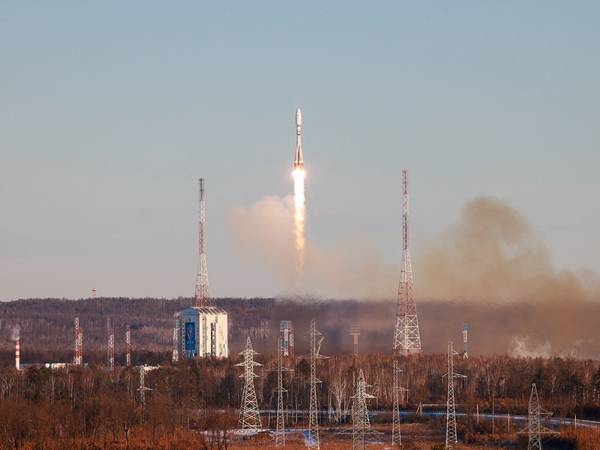Russia launched a Soyuz rocket early on Tuesday carrying 55 small satellites, including two from Iran, Russia's Roscosmos space agency reported.
The Soyuz-2.1 spacecraft lifted off from Russia's Vostochny Cosmodrome Tuesday to take satellites designed to monitor the space weather to the Earth's ionosphere, where the atmosphere meets space.
Roscosmos said that in total, 51 Russian satellites, one Russian-Chinese Device and a Russian-Zimbabwean satellite were put into orbit.
According to Iranian Ambassador to Russia Kazem Jalali, two Iranian satellites, the Kowsar, a high-resolution imaging satellite, and Hodhod, a small communications satellite, were among the satellites carried by the Soyuz.
"In continuation of the development of Iran-Russia scientific and technological cooperation, two Iranian satellites, Kowsar and Hodhod, will be launched to a 500 km orbit of earth on Tuesday, November 5, by a Soyuz launch vehicle,"Jalali said in a post on X Monday.
Iranian media says the Kowsar, which weighs 30 kilograms, has an expected lifespan of three years and the Hodhod, which weighs 4 kilograms and orbits at an altitude of 500 kilometers, can operate for four years.
The Iranian satellites are the first launched on behalf of the country’s private sector. IRNA says they were designed and built by the Omidfaza company, which began designing the satellites in 2019.
The heaviest satellites in the launch were two Russian Ionosfera-M satellites, which weigh 430 kg (948 lb) and their working orbit is at an altitude of 820 km (510 miles).
A Russian-Chinese student satellite Druzhba ATURK was also taken to space in the launch.
In February, Russia launched into space an Iranian research satellite that will scan Iran's topography from orbit, according to ISNA.
In September, Iran’s Revolutionary Guards announced the launch of a research satellite into orbit. Chamran 1 was launched aboard the Qaem 100 solid-fuel satellite launcher, also operated by the IRGC. Iranian media said the satellite was placed into orbit at an altitude of 550 kilometers, marking the IRGC's second orbital mission with this launcher.
While Iran insists that the Chamran 1 is purely a research satellite, designed to test hardware and software systems and demonstrate in-orbit maneuvering technologies, Western officials and experts say it is for military purposes.
"Iran’s space program is a cover for the regime’s longer range strike capabilities and a pathway to an Intercontinental Ballistic Missile (ICBM) that could be used to threaten the US homeland and the European continent," Behnam Ben Taleblu, a senior FDD fellow, told Iran International.
Satellite images suggested Israel struck a major Iranian missile plant during its latest strikes across Iran. The images from Planet Labs showed damage to the Shahroud Space Center which is an IRGC facility understood to be used to produce intermediate-range ballistic missiles that could be used to target Israel.
